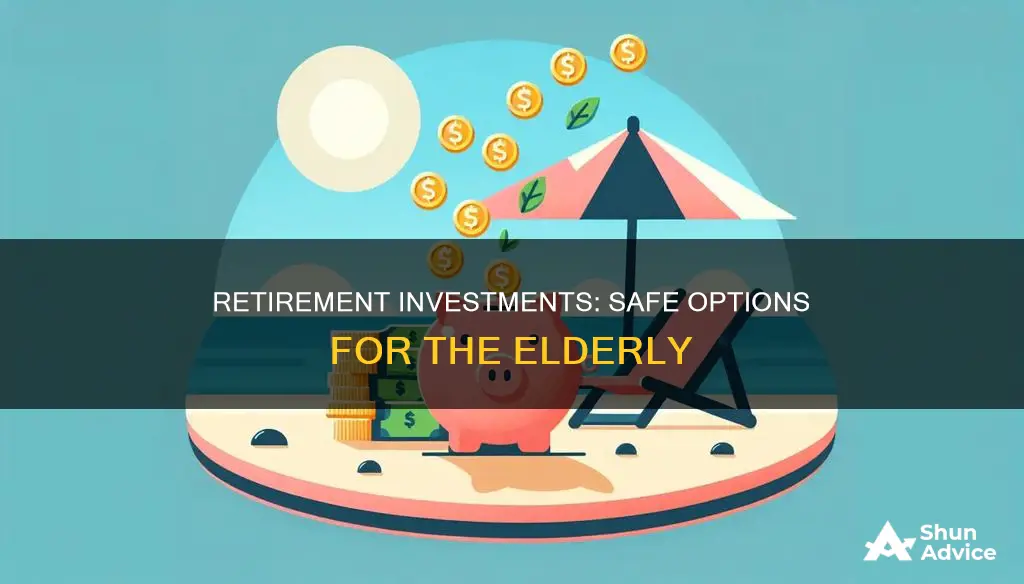
When it comes to investing as a senior citizen, it's generally advisable to reduce the risk in your portfolio. While all investments carry some risk, there are several safer options available. U.S. Treasury bills, for instance, are often considered the safest investments globally, as they are backed by the full faith and credit of the U.S. government. Treasury securities, such as Treasury inflation-protected securities (TIPS), also fall into this low-risk category.
For those seeking diversification, dividend-paying stocks, high-yield savings accounts, and certificates of deposit (CDs) are also relatively safe options. CDs are insured by the Federal Deposit Insurance Corporation (FDIC) for up to $250,000, while high-yield savings accounts can offer interest rates comparable to or higher than CDs, without early withdrawal penalties.
Additionally, fixed annuities, money market accounts, and mutual funds focusing on municipal bonds or dividend stocks can provide stable and consistent income for retirees.
| Characteristics | Values |
|---|---|
| Risk | Low |
| Returns | Low to medium |
| Investment types | High-yield savings accounts, money market accounts, certificates of deposit, dividend-paying stocks, bonds, annuities, real estate investment trusts, treasury securities, mutual funds |
What You'll Learn

High-yield savings accounts
- Interest Rates: High-yield savings accounts typically offer higher interest rates than traditional savings accounts. The best high-yield savings rates currently range from 4.50% APY to 5.30% APY, far higher than the national average savings account rate.
- Safety: High-yield savings accounts are generally safe because they are insured by the Federal Deposit Insurance Corporation (FDIC) or the National Credit Union Administration (NCUA). This means that deposits up to $250,000 per depositor are protected if the bank fails.
- Accessibility: High-yield savings accounts provide easy access to your money. While there are usually no restrictions on withdrawals, some banks may limit the number of transactions per month to avoid excessive transaction fees.
- Fees: These accounts typically have no monthly maintenance fees, minimum balance requirements, or other hidden charges. However, there may be fees for services like wire transfers or early account closure.
- Compounding Interest: High-yield savings accounts usually offer compounding interest, which means you earn interest on both your principal deposits and the interest accrued over time. This helps your savings grow faster.
- Online Availability: Many high-yield savings accounts are offered by online banks, which often have lower overhead costs and can pass on the savings to customers through higher interest rates and lower fees.
- Variable Rates: It's important to remember that high-yield savings accounts typically have variable interest rates, which means the rates can change at any time. Keep an eye on the market and be prepared for potential rate fluctuations.
- Diversification: High-yield savings accounts can be a great addition to your investment portfolio. They offer a safe and stable option to balance out riskier investments.
- Short-Term Goals: High-yield savings accounts are ideal for short-term financial goals. However, for long-term goals or retirement planning, consider other investment options with potentially higher returns, such as stocks or mutual funds.
Overall, high-yield savings accounts are a great choice for older individuals looking to grow their savings with minimal risk. They offer higher interest rates, easy access to funds, and minimal fees, making them a safe and effective tool for building your financial future.
Investments: Where People Put Their Money
You may want to see also

Money market accounts
Advantages
- Higher interest rates compared to regular savings accounts
- Check-writing and debit card privileges
- Federal insurance protection
Disadvantages
- Limited transactions
- Fees
- Minimum balance requirements
When choosing a money market account, consider the annual percentage yield (APY), fees, minimum deposit and balance requirements, customer experience, digital banking features, and accessibility of funds. Additionally, look for accounts insured by the FDIC or NCUA to ensure your funds are protected.
Dubai's Investment Trends
You may want to see also

Treasury securities
When it comes to conservative investments, Treasury securities are a safe bet for older people. These are backed by the full faith and credit of the US government, which means that the government promises to raise money by any legally available means to repay them. This makes them one of the safest investments available, with very low risk.
Treasury Bills
Treasury bills (T-bills) are short-term securities that mature in one year or less from their issue date. They are bought at a discount of the par value and, instead of paying a coupon interest, are eventually redeemed at that par value. T-bills are sold by auction, with maturities of 4, 8, 13, 17, 26, and 52 weeks.
Treasury Notes
Treasury notes (T-notes) have maturities of 2, 3, 5, 7, or 10 years, with a coupon payment every six months. They are sold in increments of $100. T-note prices are quoted on the secondary market as a percentage of the par value.
Treasury Bonds
Treasury bonds (T-bonds) have the longest maturity at 20 or 30 years. They have a coupon payment every six months like T-notes. T-bonds are also issued at and mature at a $100 par value.
Treasury Inflation-Protected Securities (TIPS)
Treasury Inflation-Protected Securities (TIPS) are inflation-indexed bonds. The coupon rate is fixed at the time of issuance, but the principal is adjusted periodically based on changes in the consumer price index (CPI). When the CPI rises, the principal is adjusted upward; if the index falls, the principal is adjusted downwards. TIPS are issued in terms of 5, 10, and 30 years.
XRP Investors: How Many?
You may want to see also

Real estate investment trusts (REITs)
REITs were created by Congress in 1960 to provide all investors, especially retail investors, with access to income-producing commercial real estate. They combine the best features of real estate and stock investment.
REITs are required to meet certain standards set by the IRS, including:
- Returning a minimum of 90% of taxable income as shareholder dividends each year
- Investing at least 75% of total assets in real estate or cash
- Receiving at least 75% of gross income from real estate, such as rents, interest on mortgages financing real property, or sales of real estate
- Having a minimum of 100 shareholders after the first year of existence
- Having no more than 50% of shares held by five or fewer individuals during the last half of the taxable year
There are several types of REITs, which can be classified by access and asset type.
Publicly traded REITs
Publicly traded REITs are traded on major stock exchanges, such as the New York Stock Exchange (NYSE) and the Nasdaq Exchange. Anyone with a brokerage account can invest in them. They must register with the U.S. Securities and Exchange Commission (SEC) and provide audited financial reports.
Public non-traded REITs
Public non-traded REITs are also open to all investors but are not traded on stock exchanges. Investors can purchase them through their financial advisor or on online portals sometimes known as real estate crowdfunding platforms. They must also register with the SEC and provide audited financial information.
Private non-traded REITs
Private non-traded REITs are not available to the public and are usually only open to high-income earners or high-net-worth individuals. They are exempt from SEC registration.
Equity REITs
Equity REITs own and operate income-producing real estate such as apartments, office buildings, and warehouses.
Mortgage REITs
Mortgage REITs, or mREITs, provide financing for real estate by purchasing or originating mortgages and mortgage-backed securities. They earn fixed income from the interest on these investments.
Hybrid REITs
Hybrid REITs invest in a combination of income-producing real estate and real estate-backed loans.
REITs offer several benefits, including:
- Passive income through high dividends
- Tax advantages
- Attractive total return potential
- Greater liquidity compared to owning real estate outright
- Transparency through audited financial statements
- Lower cost compared to buying commercial real estate outright
However, there are also some drawbacks to investing in REITs, such as:
- Higher tax liabilities due to non-qualified dividends
- Sensitivity to changes in interest rates
- Property-specific risks such as tenant move-outs and industry headwinds
- The risks associated with using too much debt
Scams: Why People Fall for Investment Schemes
You may want to see also

Dividend-paying stocks
Dividend yield is a ratio that shows how much income you earn in dividend payouts per year for every dollar invested in a stock. Dividend yield is expressed as a percentage point. For example, if a utilities company's stock costs $50 per share and pays out annual dividends of $2 per share, the dividend yield would be 4%. This means you would earn 4% in dividends per year in this example. Dividend-yielding stocks usually pay their shareholders in cash, but dividends can also be paid in stocks or other property.
When considering dividend-paying stocks, it is important to evaluate the dividend yield and ensure that it is not too high, as this could be a red flag. A very high dividend yield could indicate that the payout is unsustainable or that the company is going into debt to pay out dividends. It is also important to consider the company's payout ratio, which is the percentage of its income that is being used to pay dividends. A payout ratio above 80% may indicate that the company is not retaining enough earnings for future growth.
Some examples of dividend-paying stocks include:
- International Business Machines (IBM): IBM has a long history of innovation in the computing industry and has successfully navigated changes in the information and technology sector. It currently has a dividend yield of 4.5%.
- Chevron (CVX): Chevron is a global leader in oil and gas and has recently begun investing in alternative energy sources. It offers a dividend yield of 3.2%.
- Coca-Cola (KO): Coca-Cola is a global beverage giant that has remained at the forefront of market trends and consumer expectations. It has a dividend yield of 3.2%.
- Johnson & Johnson (JNJ): Johnson & Johnson is a well-known healthcare company that has been at the forefront of innovation in its industry. It has a dividend yield of 2.4%.
- Altria Group (MO): Altria is a tobacco company that sells cigarettes, chewing tobacco, cigars, and e-cigarettes under various brands, including Marlboro. It offers a dividend yield of 8.4%.
- Walgreens Boots Alliance (WBA): Walgreens Boots Alliance is the largest retail pharmacy in the United States and Europe, with a presence in 9 countries. It has a dividend yield of 8.6%.
It is important to note that dividend-paying stocks come with risks, including stock price fluctuations and changes in a company's dividend policy. Additionally, dividends may be subject to taxation, depending on the investor's jurisdiction.
Who Invests and Why?
You may want to see also
Frequently asked questions
Safe investment options for seniors include high-yield savings accounts, certificates of deposit, treasury bills, notes, bonds, and TIPS.
A 70-year-old should consider investing in treasury securities, dividend-paying stocks, and annuities.
A high-yield savings account is the safest investment option, as there is little to no risk of losing money. However, the interest rate will be low.
Retired people can consider investing in REITs, dividend-paying stocks, annuities, treasury securities, certificates of deposit, and money market accounts.







